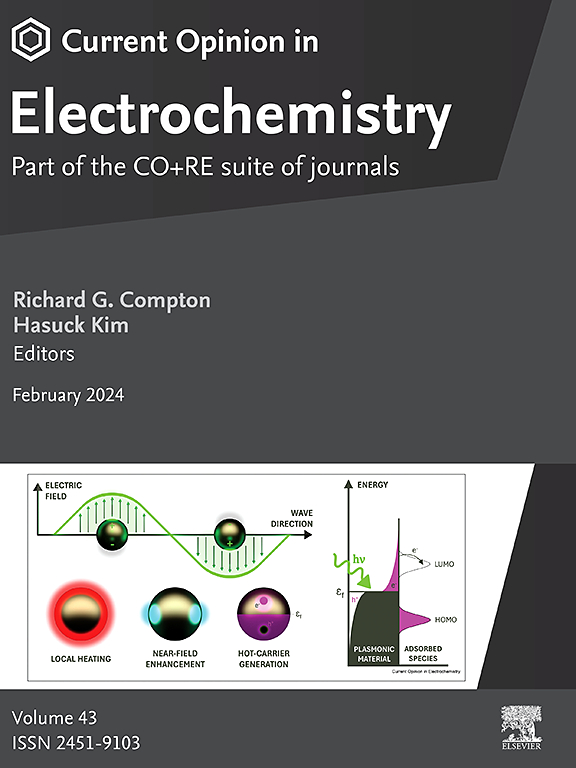电化学反应分离使电气化氮制造和修复成为可能
IF 6.9
2区 化学
Q1 CHEMISTRY, PHYSICAL
引用次数: 0
摘要
无机氮表现出广泛的氧化态和社会用途。由于其氧化态的控制,电化学非常适合平衡氮循环的挑战,人类已经通过化学制造,农业和废水处理彻底改变了氮循环。各种各样的含氮原料表明需要反应性电化学分离,结合电催化产生各种氮和电化学分离来纯化它们。我们详细介绍了电催化的最新进展和交叉见解,重点是转化丰富的反应物,如二氮、氨和硝酸盐;利用电化学电位作为驱动力以及各种分离机制(如电荷、挥发性)的电化学分离;电化学反应性分离利用了反应器结构和关键部件的创新。目前,二氮被还原成氨,然后被氧化成其他氮途径。使用氨以外的反应物并分离不稳定中间体的电催化途径为创新提供了具有挑战性但具有影响力的机会。当我们考虑整合环境修复和化学制造的低质量原料时,将需要选择膜,电极,吸附剂和工艺。对于新工艺,分子催化剂尚未充分用于处理低品位原料,但可以应用于催化膜或反应器结构中,以提取反应物并促进工程微环境中的催化作用。总的来说,电化学和电化学工程师有很多机会将他们的技能应用于创造维持人类健康和环境质量的循环氮经济的关键挑战。本文章由计算机程序翻译,如有差异,请以英文原文为准。
Electrochemical reactive separations enable electrified nitrogen manufacturing and remediation
Inorganic nitrogen species exhibit a wide spectrum of oxidation states and societal uses. Due to its control of oxidation states, electrochemistry is well-suited to the challenge of balancing the nitrogen cycle, which humans have drastically altered via chemical manufacturing, agriculture, and wastewater treatment. The wide variety of feedstocks that contain nitrogen species evinces a need for reactive electrochemical separations that integrate electrocatalysis to generate various species and electrochemical separations to purify them. We detail recent progress and cross-cutting insights in electrocatalysis with a focus on converting abundant reactants such as dinitrogen, ammonia, and nitrate; electrochemical separations that leverage electrochemical potential as a driving force along with various separation mechanisms (e.g., charge, volatility); and electrochemical reactive separations that leverage innovations in reactor architectures and key components. Currently, dinitrogen is reduced to ammonia, which is then oxidized to other nitrogen pathways. Electrocatalytic pathways that use reactants other than ammonia and that isolate unstable intermediates present challenging but impactful opportunities for innovation. As we consider lower-quality feedstocks that integrate environmental remediation and chemical manufacturing, selective membranes, electrodes, adsorbents, and processes will be required. For novel processes, molecular catalysts have been underutilized for treating low-grade feedstocks but can be applied in catalytic membranes or reactor architectures that extract reactants and facilitate catalysis in engineered microenvironments. Overall, opportunities abound for electrochemists and electrochemical engineers to apply their skill sets towards the critical challenge of creating circular nitrogen economies that sustain human health and environmental quality.
求助全文
通过发布文献求助,成功后即可免费获取论文全文。
去求助
来源期刊

Current Opinion in Electrochemistry
Chemistry-Analytical Chemistry
CiteScore
14.00
自引率
5.90%
发文量
272
审稿时长
73 days
期刊介绍:
The development of the Current Opinion journals stemmed from the acknowledgment of the growing challenge for specialists to stay abreast of the expanding volume of information within their field. In Current Opinion in Electrochemistry, they help the reader by providing in a systematic manner:
1.The views of experts on current advances in electrochemistry in a clear and readable form.
2.Evaluations of the most interesting papers, annotated by experts, from the great wealth of original publications.
In the realm of electrochemistry, the subject is divided into 12 themed sections, with each section undergoing an annual review cycle:
• Bioelectrochemistry • Electrocatalysis • Electrochemical Materials and Engineering • Energy Storage: Batteries and Supercapacitors • Energy Transformation • Environmental Electrochemistry • Fundamental & Theoretical Electrochemistry • Innovative Methods in Electrochemistry • Organic & Molecular Electrochemistry • Physical & Nano-Electrochemistry • Sensors & Bio-sensors •
 求助内容:
求助内容: 应助结果提醒方式:
应助结果提醒方式:


